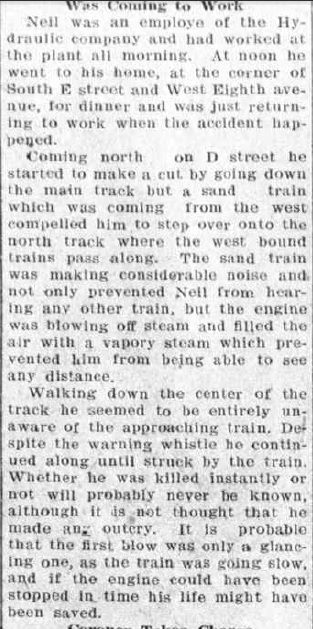
Monmouth, Illinois, Republican-Atlas of 22 November 1906
Joseph Neill’s accidental train death in 1906 took place in the middle of the day as he was returning from work, just minutes after he had left his home. Our transcription of the newspaper account continues:
Was Coming to Work
Neil was an employe of the Hydraulic company and had worked at the plant all morning. At noon he went to his home, at the corner of South E street and West Eighth avenue, for dinner and was just returning to to work when the accident happened.
Coming north on D street he started to make a cut by going down the main track but a sand train which was coming from the west compelled him to step over onto the north track where the west bound trains pass along. The sand train was making considerable noise and not only prevented Neil from hearing any other train, but the engine was blowing off steam and filled the air with a vapory steam which prevented him from being able to see any distance.
Walking down the center of the track he seemed to be entirely unaware of the approaching train. Despite the warning whistle he continued along until struck by the train. Whether he was killed instantly or not will probably never be known, although it is not thought that he made any outcry. It is probable that the first blow was only a glancing one, as the train was going slow, and if the engine could have been stopped in time his life might have been saved.
Online maps don’t indicate that there currently are homes at the corner where Neill is indicated as residing at the time of the accident. What I need are contemporary maps to determine what streets were in existence in 1906. Further research into the hydraulic company is warranted as well, but based upon the newspaper account it was located somewhat north of where Neill lived. It is doubtful employment records are still extant, but it should be possible to learn more about it.
Newspapers can easily leave out details if they are things that “everyone knows.” After all, they are called “news” papers. The problem is that when reading a newspaper 110 years after it was written, that contemporary knowledge is gone. The set of double train tracks still run through Monmouth, Illinois–so that has not changed. In fact, they run all the way from the Mississippi River to Chicago.

No responses yet